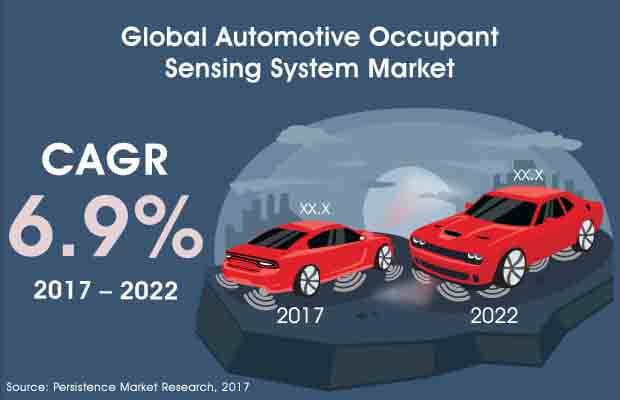Automotive Occupant Sensing System Market Segmented By Mid-sized Passenger Cars, Luxury Passenger Cars, Light Commercial Vehicles, Heavy Commercial Vehicles, Premium Passenger Cars, Compact Passenger Cars Vehicle for Passenger Side, Driver Side Mounting Location
Industry: Automotive & Transportation
Published Date: October-2017
Format: PPT*, PDF, EXCEL
Delivery Timelines: Contact Sales
Number of Pages: 170
Report ID: PMRREP3480
Safety is a paramount concern for both a driver as well as all the occupants inside a moving vehicle. Seatbelts and airbags are the two most-known vehicle safety features that help save innumerable lives every year. The automotive occupant sensing system detects the presence and position of an individual seated on either the driver’s seat or passenger’s seat in a vehicle.
These systems are also able to sense the presence of rear facing child seats inside a vehicle thus control the amount of deflation or inflation required by airbags in the case of a major accident. The steady stream of information from the automotive occupant sensing system to the airbag activator control system enables the former to work without hitch. The automotive occupant sensing system market is projected to be worth more than US$ 2 billion by the end of 2022.

Compact cars and mid-sized passenger cars combined have a revenue share greater than half of the automotive occupant sensing system market by vehicle type segment in 2017 and should remain in strong demand for the foreseeable future. Compact cars are top-sellers in APEJ as these cars are cost-effective and easier to maneuver in traffic.
The APEJ compact car passenger segment is on track to record a robust CAGR of more than 9%, making it large enough for all key stakeholders in the automotive occupant sensing system market. On the other hand, mid-sized passenger cars have greater appeal in North America because of a high disposable income in the region coupled with lower prices of gasoline.
The North America mid-sized passenger car market has a market share of approx. a third of the automotive occupant sensing system market in 2017 and it is expected to grow with a high CAGR.
Luxury passenger cars have a large market in North America as consumers there are typically less price-sensitive than their counterparts in emerging economies and often seek out the best available choice. The North America luxury passenger car segment is the only one anticipated to push past a value of US$ 65 million at the end of the forecast period.
A similar opportunity exists in the premium car segment of the automotive occupant sensing system market. Europe closely follows North America in the premium car segment because the continent has a long-standing heritage of manufacturing premium cars and several globally-renowned carmakers have their headquarters on the continent.
The OEM segment accounts for the lion’s share of revenue in the automotive occupant sensing system market by sales channel segment in 2017 and is projected to gain share in the future.
An absolute dollar opportunity of more than US$ 540 million is waiting to be tapped in the OEM segment of the automotive occupant sensing system market.
Persistence Market Research has profiled some of the most prominent companies that have shaped the automotive occupant sensing system market.
The companies are Takata Corporation, Autoliv Inc, Robert Bosch GMBH, Continental AG, Delphi Automotive Plc., Hyundai Mobis Co., Lear Corporation, ZF Friedrichshafen AG, Key Safety Systems Inc., and Volvo AB.
| Attribute | Details |
|---|---|
|
Region |
|
|
Vehicle Type |
|
|
Sales Channel |
|
|
Mounting Location |
|
To know more about delivery timeline for this report Contact Sales
